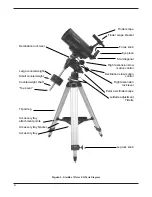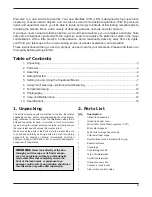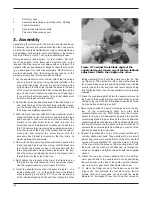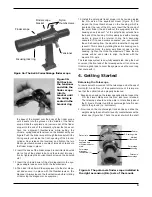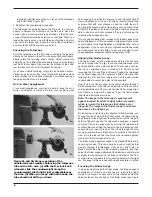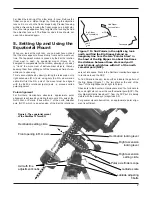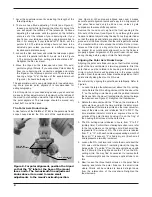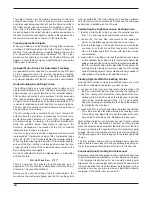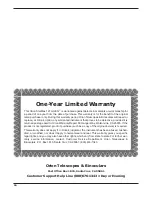
6
remains horizontal even when you let go of the telescope
with both hands (Figure 5b).
3. Retighten the counterweight lock knob.
The telescope is now balanced on the R.A. axis. It is not nec-
essary to balance the telescope on the Dec. axis, since the
optical tube’s mounting plate is positioned so that the tele-
scope will automatically be balanced on that axis. When you
loosen the lock lever on one or both axes of motion and man-
ually point the telescope, it should move without resistance
and should not drift from where you point it.
Focusing the Telescope
Point the telescope so the front end is aimed in the general
direction of an object at least 1/4-mile away. With your fingers,
slowly rotate the focusing knob until the object comes into
sharp focus. Go a little bit beyond sharp focus until the image
just starts to blur again, then reverse the rotation of the knob,
just to make sure you’ve hit the exact focus point.
If you have trouble focusing, rotate the focus knob counter-
clockwise as far as it will go. Look through the eyepiece while
slowly rotating the focus knob clockwise. You should soon see
the point at which focus is reached.
Do You Wear Eyeglasses?
If you wear eyeglasses, you may be able to keep them on
while you observe. In order to do this, your eyepiece must
have enough “eye relief” to allow you to see the entire field of
view with glasses on. You can try this by looking through the
eyepiece first with your glasses on and then with them off,
and see if the glasses restrict the view to only a portion of the
full field. If the glasses do restrict the field of view, you may be
able to observe with your glasses off by just refocusing the
telescope the needed amount.
If your eyes are astigmatic, images will probably appear the
best with glasses on. This is because a telescope’s focuser can
accommodate for nearsightedness or farsightedness, but not
astigmatism. If you have to wear your glasses while observing
and cannot see the entire field of view, you may want to pur-
chase additional eyepieces that have longer eye relief.
Aligning the Finder Scope
The finder scope must be aligned accurately with the tele-
scope for proper use. To align it, aim the main telescope in the
general direction of an object at least 1/4-mile away, such as
the top of a telephone pole, a chimney, etc. Do this by first
loosening the R.A. and Dec. lock levers. Position the telescope
so the object appears in the eyepiece’s field of view and then
retighten the R.A. and Dec. lock levers. Use the slow-motion
control cables to center the object in the eyepiece.
Now, look in the finder scope. Is the object visible? Ideally, it
will be somewhere in the finder’s field of view. If it is not, some
coarse adjustments of the two black nylon finder scope align-
ment thumb screws will be needed to get the finder scope
roughly parallel to the main tube.
Note: The image in the telescope’s eyepiece will
appear inverted from left-to-right (mirror reversed),
which is normal for telescopes that utilize a star
diagonal. The image in the finder scope is oriented
the same as the naked eye.
By loosening or tightening the alignment thumbscrews, you
change the line of sight of the finder scope. Continue making
adjustments to the alignment thumbscrews until the image in
both the finder scope and the telescope’s eyepiece is exactly
centered. Check the alignment by moving the telescope to
another object and fixing the finder scope’s crosshairs on the
exact point you want to look at. Then look through the tele-
scope’s eyepiece to see if that point is centered in the field of
view. If it is, the job is done. If not, make the necessary adjust-
ments until the two images match up.
The finder scope alignment needs to be checked before every
observing session. This can easily be done at night, before
viewing through the telescope. Choose any bright star or
planet, center the object in the telescope eyepiece, and then
adjust the finder scope’s alignment thumbscrews until the star
or planet is also centered on the finder’s crosshairs. The find-
er scope is an invaluable tool for locating objects in the night
sky; its usage for this purpose will be discussed later, in detail.
Focusing the Finder Scope
If, when looking through the finder scope, the images appear
somewhat out of focus, you will need to refocus the finder
scope for your eyes. Loosen the lock ring located behind the
objective lens cell on the body of the finder scope (see Figure
Figure 5a and 5b: Proper operation of the
equatorial mount requires balancing the telescope
tube on the R.A. axis. (a) With the R.A. lock knob
released, slide the counterweight along the
counterweight shaft until it just counterbalances
the tube. (b) When you let go with both hands, the
tube should not drift up or down
a.
b.


